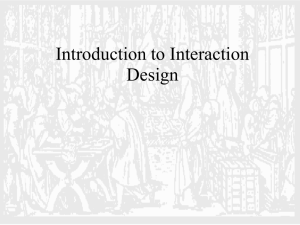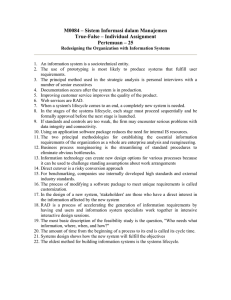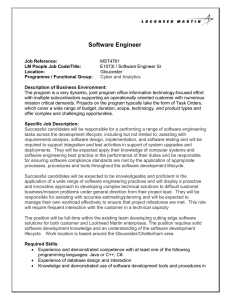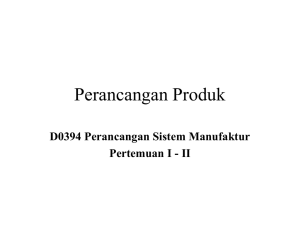Testing in the Lifecycle
advertisement
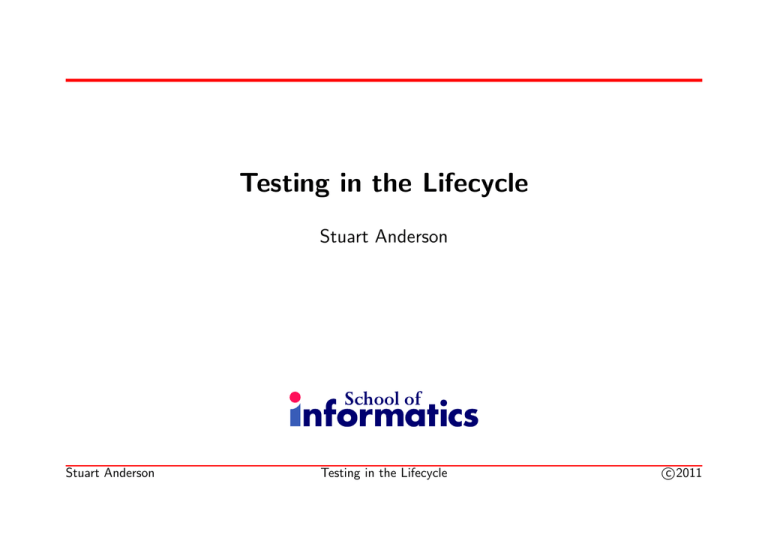
Testing in the Lifecycle Stuart Anderson Stuart Anderson Testing in the Lifecycle c 2011 1 Software was difficult to get right in 1982 Stuart Anderson Testing in the Lifecycle c 2011 A 1995 Department of Defence Software Study 2 It was still difficult in 1995 Stuart Anderson Testing in the Lifecycle c 2011 Success rate of government IT projects and programmes 3 ...and in 2007 Source: The Guardian, 18 May 2007 Figures from Department for Work and Pensions spokesman (63%) And Joe Harley, Chief Information Officer, DWP (30%) Stuart Anderson Testing in the Lifecycle c 2011 4 And testing costs are significant Stuart Anderson Testing in the Lifecycle c 2011 Slide 4: References Winokur, M.; Grinman, A.; Yosha, I.; Gallant, R.; Measuring the effectiveness of introducing new methods in the software development process, Euromicro Conference, 1998. Proceedings. 24th , vol.2, no., pp.800-807 vol.2, 25-27 Aug 1998. DOI: http://dx.doi.org/10.1109/EURMIC.1998.708105 5 Cost of Testing vs Cost of Defects • NIST report (2002): “The Economic Impacts of Inadequate Infrastructure for Software Testing” http://www.nist.gov/director/planning/upload/report02-3.pdf • Notes that “developers already spend approximately 80% of software development costs on identifying and correcting defects”. • “Identifying and correcting defects” not necessarily the same thing as the cost of testing, but still... Stuart Anderson Testing in the Lifecycle c 2011 6 Costs of fixing defects found at different stages Stuart Anderson Testing in the Lifecycle c 2011 7 Costs of Defects • Defects in the specification are even more costly to remove if we do not eliminate them early. • Different software lifecycles distribute testing (verification — ‘building the thing right’, and validation – ‘building the right thing’ ) differently. • The different distributions of test activity can have an impact on where bugs are discovered. • We consider three representative lifecycles and consider where testing is located in each: The V-model, Boehm’s spiral model and eXtreme Programming (XP) Stuart Anderson Testing in the Lifecycle c 2011 8 Recap: Waterfall model of software development 1. 2. 3. 4. 5. Requirements Design Implementation Testing Release and maintenance Sequential, no feedback — Ironically its “author”, Royce, presented it as an example of a broken model Stuart Anderson Testing in the Lifecycle c 2011 9 V-model Stuart Anderson Testing in the Lifecycle c 2011 10 V-model Rationale • This is a modified version of the waterfall model. • Tests are created at the point the activity they validate is being carried out. So, for example, the acceptance test is created when the systems analysis is carried out. • Failure to meet the test requires a further iteration beginning with the activity that has failed the validation. • V-model is focused on creating tests in a structured manner. • It is popular with developers of systems that are highly regulated because it is well suited to creating evidence that can be used to justify a system to a regulator. Stuart Anderson Testing in the Lifecycle c 2011 11 Boehm’s Spiral Model Stuart Anderson Testing in the Lifecycle c 2011 12 Spiral Model Rationale • The spiral model is focused on controlling project risk and attempting formally to address project risk throughout the lifecycle. • V&V activity is spread through the lifecycle with more explicit validation of the preliminary specification and the early stages of design. The goal here is to subject the early stages of design to V&V activity. • At the early stages there may be no code available so we are working with models of the system and environment and verifying that the model exhibits the required behaviours. Stuart Anderson Testing in the Lifecycle c 2011 13 XP principles • eXtreme Programming advocates working directly with code almost all the time. • The 12 principles of XP summarise the approach. • Development is test-driven. • Tests play a central role in refactoring activity. • “Agile” development mantra: Embrace Change. Stuart Anderson Testing in the Lifecycle 1. 2. 3. 4. 5. 6. 7. 8. 9. 10. 11. 12. Test-driven development The planning game On-site customer Pair programming Continuous integration Refactoring Small releases Simple design System metaphor Collective code ownership Coding standards 40-hour work week c 2011 14 eXtreme Programming (XP) http://www.extremeprogramming.org/map/project.html Stuart Anderson Testing in the Lifecycle c 2011 15 Summary • We have considered three different approaches to the lifecycle and have seen how testing fits in the lifecycles. • Each approach will have a different testing cost and cost-profile through the lifecycle. • Lifecycles are often dependent on the type of product and how well we understand project risk. Stuart Anderson Testing in the Lifecycle c 2011 16 Required Readings • Textbook (Pezzè and Young): Chapter 4, Test and Analysis Activities within a Software Process • Textbook (Pezzè and Young): Chapter 20, Planning and Monitoring the Process Stuart Anderson Testing in the Lifecycle c 2011 17 Suggested Readings • Gregory M. Kapfhammer, Software Testing, In A. Tucker (Ed.), Second Edition, The Computer Science and Engineering Handbook, Chapter 105, CRC Press, 2004. • Mary Jean Harrold. 2000. Testing: a roadmap. In Proceedings of the Conference on The Future of Software Engineering (ICSE ’00). ACM, New York, NY, USA, 61-72. DOI: http://dx.doi.org/10.1145/336512.336532 • Winokur, M.; Grinman, A.; Yosha, I.; Gallant, R.; Measuring the effectiveness of introducing new methods in the software development process, Euromicro Conference, 1998. Proceedings. 24th , vol.2, no., pp.800-807 vol.2, 25-27 Aug 1998. DOI: http://dx.doi.org/10.1109/EURMIC.1998.708105 Stuart Anderson Testing in the Lifecycle c 2011
